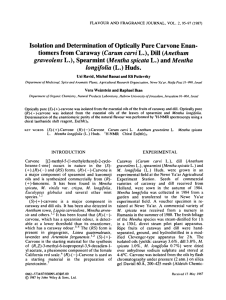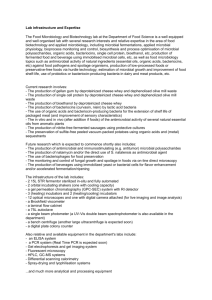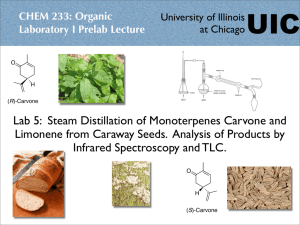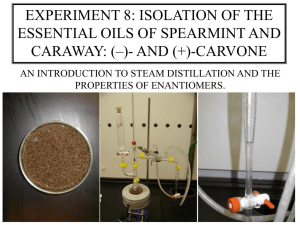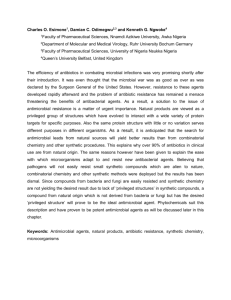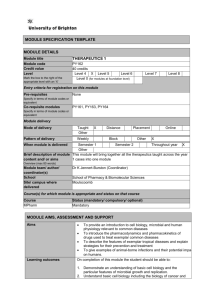Microbial Transformation of (–)
advertisement
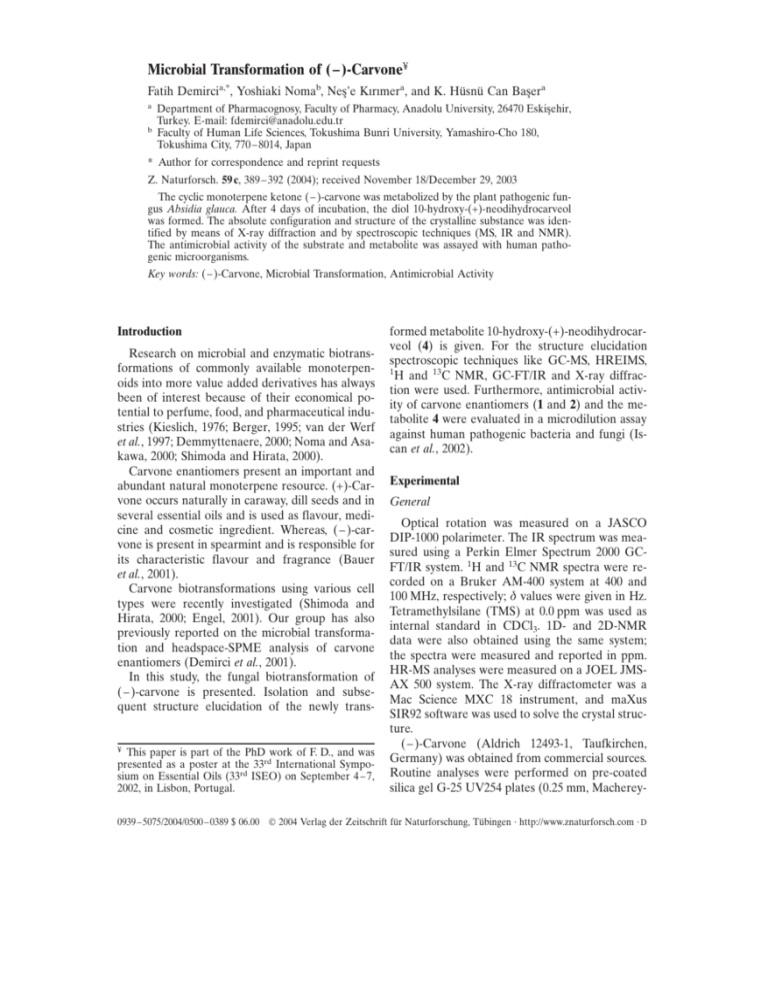
Microbial Transformation of (Ð)-Carvone¥ Fatih Demircia,*, Yoshiaki Nomab, Neş’e Kırımera, and K. Hüsnü Can Başera a b Department of Pharmacognosy, Faculty of Pharmacy, Anadolu University, 26470 Eskişehir, Turkey. E-mail: fdemirci@anadolu.edu.tr Faculty of Human Life Sciences, Tokushima Bunri University, Yamashiro-Cho 180, Tokushima City, 770Ð8014, Japan * Author for correspondence and reprint requests Z. Naturforsch. 59 c, 389Ð392 (2004); received November 18/December 29, 2003 The cyclic monoterpene ketone (Ð)-carvone was metabolized by the plant pathogenic fungus Absidia glauca. After 4 days of incubation, the diol 10-hydroxy-(+)-neodihydrocarveol was formed. The absolute configuration and structure of the crystalline substance was identified by means of X-ray diffraction and by spectroscopic techniques (MS, IR and NMR). The antimicrobial activity of the substrate and metabolite was assayed with human pathogenic microorganisms. Key words: (Ð)-Carvone, Microbial Transformation, Antimicrobial Activity Introduction Research on microbial and enzymatic biotransformations of commonly available monoterpenoids into more value added derivatives has always been of interest because of their economical potential to perfume, food, and pharmaceutical industries (Kieslich, 1976; Berger, 1995; van der Werf et al., 1997; Demmyttenaere, 2000; Noma and Asakawa, 2000; Shimoda and Hirata, 2000). Carvone enantiomers present an important and abundant natural monoterpene resource. (+)-Carvone occurs naturally in caraway, dill seeds and in several essential oils and is used as flavour, medicine and cosmetic ingredient. Whereas, (Ð)-carvone is present in spearmint and is responsible for its characteristic flavour and fragrance (Bauer et al., 2001). Carvone biotransformations using various cell types were recently investigated (Shimoda and Hirata, 2000; Engel, 2001). Our group has also previously reported on the microbial transformation and headspace-SPME analysis of carvone enantiomers (Demirci et al., 2001). In this study, the fungal biotransformation of (Ð)-carvone is presented. Isolation and subsequent structure elucidation of the newly trans- ¥ This paper is part of the PhD work of F. D., and was presented as a poster at the 33rd International Symposium on Essential Oils (33rd ISEO) on September 4Ð7, 2002, in Lisbon, Portugal. 0939Ð5075/2004/0500Ð0389 $ 06.00 formed metabolite 10-hydroxy-(+)-neodihydrocarveol (4) is given. For the structure elucidation spectroscopic techniques like GC-MS, HREIMS, 1 H and 13C NMR, GC-FT/IR and X-ray diffraction were used. Furthermore, antimicrobial activity of carvone enantiomers (1 and 2) and the metabolite 4 were evaluated in a microdilution assay against human pathogenic bacteria and fungi (Iscan et al., 2002). Experimental General Optical rotation was measured on a JASCO DIP-1000 polarimeter. The IR spectrum was measured using a Perkin Elmer Spectrum 2000 GCFT/IR system. 1H and 13C NMR spectra were recorded on a Bruker AM-400 system at 400 and 100 MHz, respectively; δ values were given in Hz. Tetramethylsilane (TMS) at 0.0 ppm was used as internal standard in CDCl3. 1D- and 2D-NMR data were also obtained using the same system; the spectra were measured and reported in ppm. HR-MS analyses were measured on a JOEL JMSAX 500 system. The X-ray diffractometer was a Mac Science MXC 18 instrument, and maXus SIR92 software was used to solve the crystal structure. (Ð)-Carvone (Aldrich 12493-1, Taufkirchen, Germany) was obtained from commercial sources. Routine analyses were performed on pre-coated silica gel G-25 UV254 plates (0.25 mm, Macherey- ” 2004 Verlag der Zeitschrift für Naturforschung, Tübingen · http://www.znaturforsch.com · D 390 F. Demirci et al. · Microbial Transformation of (Ð)-Carvone Nagel, Düren, Germany) using n-hexane/acetone (75:25, v/v) as solvent system. Visualization was under UV (254/366 nm) and/or by spraying with anisaldehyde/H2SO4 spray reagent. Microorganisms and biotransformation Stock cultures were maintained on agar slants (SDA, Acumedia, Baltimore, Maryland, USA), stored at 4 ∞C and refreshed every 6 months. Absidia glauca (ATCC 22752) was cultivated at room temperature in 250 ml-culture flasks containing 100 ml sterile (121 ∞C, 20 min, autoclaved) α-medium [consisting of 20 g glucose; 5 g NaCl; 5 g K2HPO4; 5 g yeast extract (Acumedia, Baltimore, Maryland, USA); 5 g peptone (Sigma, St. Louis, MO, USA) per litre of distilled water adjusted to pH 7.0]. Culture flasks were shaken at 140 rpm. After 24Ð48 h of sufficient growth of the microorganisms, 50 µl of substrate [(Ð)-carvone] was added and incubated for 7 d. The biotransformation products were screened by liquid-liquid extraction of the withdrawn broth (3 ml) which was extracted exhaustively by ethyl acetate, concentrated and evaluated by TLC and GC-MS analysis. Substrate controls were composed of sterile medium to which the substrate (50 µl) was added and incubated without the microorganism. Culture controls consisted of fermentation blanks in which the microorganism was grown under identical conditions but without the addition of substrate. After 7 d of incubation, controls were also harvested and analysed by TLC. Gas chromatography mass spectrometry (GC-MS) conditions The samples were analyzed and screened by GC-MS using a Hewlett Packard GCD system. Innowax FSC column (60 m x 0.25 mm i.d., 0.25 µm film thickness) was used with helium as a carrier gas (1.5 ml/min). GC oven temperature was kept at 100 ∞C for 5 min and programmed to 220 ∞C at a rate of 20 ∞C/min, and then kept constant at 220 ∞C for 11.5 min. Injection was carried out in splitless mode. The injector temperature was at 250 ∞C. Mass spectra were recorded at 70 eV and mass range was from m/z 35 to 425. Library search was carried out using the in-house library “Baser Library of Essential Oil Constituents” and in comparison with authentic samples. Relative percentage amounts were calculated from TIC by the computer. Semi-preparative scale biotransformation and isolation The substrate (Ð)-carvone (175 mg) was distributed among three 250 ml-flasks containing 100 ml broth plus the microorganism that was sufficiently pre-grown as described above at room temperature for 4 d. The biotransformation was stopped by adding EtOAc to the flasks and the broths were combined and extracted with equal amounts of EtOAc successively. After filtration of the mycelia, the extracts were dried over anhydrous sodium sulfate and concentrated in vacuo to yield a brown gum (ca. 250 mg). The biotransformation extract was then subjected to column chromatography (nhexane 5 EtOAc; 100 5 0). Compound 4 was eluted in 40% EtOAc to give colourless crystals (10 mg) having a characteristic odour. 10-Hydroxy-(+)-neodihydrocarveol [8(9)-p-men27 = + 25.8 ∞ (c thene-2,10-diol, C10H18O2] (4): [α]D 0.356, CHCl3). Ð Rf = 0.3 (n-hexane/EtOAc, 6:1, v/v). Ð GC-FT/IR: νmax = 3659 (OH), 3037, 2934, 2880, 1645, 1454, 1377, 1026 cmÐ1. Ð 1H NMR (400 MHz): δ = 1.03 (3H, d, J = 6.4 Hz, H-7), 3.2 (1H, m, H-2), 4.13 (2H, s, H-10), 4.91 and 5.04 (2H, 2s, H-9). Ð 13C NMR (100 MHz): δ = 36.1 (C-1), 70.9 (C-2), 39.0 (C-3), 33.1 (C-4), 28.2 (C-5), 31.6 (C-6), 18.3 (C-7), 153.6 (C-8), 108.3 (C-9), 65.2 (C-10). Ð EI/MS: m/z = 170 [M+], 152 (3) [M+H2O], 134 (87), 119 (100), 106 (77), 105 (55), 95 (82), 93 (60), 81 (61), 79 (74), 67 (87), 55 (82), 41 (98). (+)-trans-Dihydrocarvone (2) (C10H16O): GCFT/IR: νmax = 3342, 3085, 2941, 2879, 1729, 1648, 1451, 1375, 1210 cmÐ1. Ð EI/MS: m/z = 152 (17) [M+], 137 (14), 123 (5), 109 (36), 95 (69), 82 (42), 81 (43), 68 (50), 67 (100), 55 (31), 41 (57). (+)-Neodihydrocarveol (3) (C10H18O): GC-FT/ IR: νmax = 3660 (OH), 3083, 2935, 2878, 1644, 1454, 1377, 1222, 993 cmÐ1. Ð EI/MS: m/z = 154 (1) [M+], 136 (73), 121 (86), 107 (100), 93 (87), 79 (98), 68 (39), 67 (58), 55 (48), 41 (75). Antimicrobial assay Microdilution broth susceptibility assay (Iscan et al., 2002) was used for the antimicrobial evaluation of the substrate and metabolite. Stock solution was prepared in dimethylsulfoxide (DMSO) and dilution series were prepared up to 0.97 µg/ml using sterile distilled water in 96-well microtiter plates. Overnight grown microbial suspensions in double strength Mueller-Hinton broth and suspen- F. Demirci et al. · Microbial Transformation of (Ð)-Carvone sion of Candida albicans in yeast medium were standardized to approximately 108 CFU/ml (using McFarland No: 0.5). 100 µl of each microbial suspension was then added to each well. The last row containing only the serial dilutions of antimicrobial agent without microorganism was used as negative control. Sterile distilled water and medium served as a positive growth control. After incubation at 37 ∞C for 24 h the first well without turbidity was determined as the minimal inhibition concentration (MIC) expressed both in µg/ml and mm, as seen in Table I. Chloramphenicol was used as standard antibacterial agent for the bacteria, whereas ketoconazole was used for C. albicans. Microorganisms were kindly supplied by the Microbiology Department of Osmangazi University (O. G. Ü), Medical Faculty (see Table I for the results). Results and Discussion (Ð)-Carvone (1) was incubated with the plant pathogenic fungus Absidia glauca for 7 d. Preliminary TLC screening showed a new metabolite at the fourth day; it was confirmed by GC-MS analysis along with known major metabolites such as (+)-trans-dihydrocarvone (2) and (+)-neodihydrocarveol (3) which already were published in our previous work (Demirci et al., 2001). These metabolites could be expected due to the reaction mechanism and stages (Fig. 1). Regarding the unknown new metabolite, although the molecular ion peak was absent, another peak [152 + H2O] having the characteristic carveol spectrum led to a previously reported (Tahara and Sakuda, 1976) synthetic diol after a detailed literature and structure search. Very recently, the carvone-diol was also described by the work of Matsumura et al. (2002), however, as a hydrolyzed product from a glucoside which was isolated from a methanolic extract of Carum carvi fruits. We have also pre- O OH O A. glauca OH 4d OH 1 2 3 4 Fig. 1. The biotransformation of (Ð)-carvone (1) and its metabolism to the diol 10-hydroxy-(+)-neodihydrocarveol (4) via (+)-trans-dihydrocarvone (2) and (+)-neodihydrocarveol (3) in 4 days. 391 viously reported on several enantiomers as biotransformation products of carvone, however, this compound could not be detected by means of headspace-SPME at that time (Demirci et al., 2001). This compound was purified from the microbial transformation broth using the EtOAc extract via column chromatography. Apolar to polar gradient elution starting from n-hexane allowed the isolation of pure crystals which were subjected to further spectroscopic analyses. The 1H NMR spectrum showed at δ 1.03 a methyl group demonstrating that there was no change at position 1, but at position 10, where the methyl was transformed to a methylene group. The broad signal at δ 4.13 with an integration of 2 H suggested that there were two hydroxyl groups in the molecule which also was supported by mass spectroscopic data. In addition, GC-FT/IR analysis showed a characteristic OH peak at 3659 nm. Furthermore, HREIMS data gave the molecular formula as C10H18O2. Finally, the evidence of the diol 4 was proven by X¸ Å] as monoray diffraction [λ(Cu Kα) = 1.54051 clinic; space group P21, with a = 7.642 (1) Å, b = 18.353 (8) Å, c = 10.688 (5) Å, β = 92.50 (5)∞, V = 1497.65 (1) Å3, Z = 4. Scattering-factors were used according to Waasmaier and Kirfel (1995). The final R value was 0.067 for 1741 reflections. To the best of our knowledge, the isolation and absolute configuration of 10-hydroxy-(+)-neodihydrocarveol (4) via biotransformation is reported with this work for the first time. As stated above, previous reports on the synthesis (Tahara and Sakuda, 1976) and a glucoside derivative (Matsumura et al., 2002) were found during the structure search. The spectroscopic and physical data of metabolite 4 was comparable to the recent work of Matsumura et al. (2002). The substrate (Ð)-carvone (1) and its (+)-isomer, as well as the metabolite 4 were subjected to a microdilution broth assay (Iscan et al., 2002) against various gram positive and negative human pathogenic bacteria and the yeast Candida albicans. Surprisingly, the metabolite showed less inhibitory activity compared to both carvones and the standard antimicrobial agents. Since it is more polar compound it was expected to be more active than its counterparts. However, the inhibitory activity was rather moderate. On the other hand, since metabolites synthesized as a result of a biotransformation process, they may be considered as a detoxification product. This may explain the low 392 F. Demirci et al. · Microbial Transformation of (Ð)-Carvone Table I. Antimicrobial activity# of carvones and metabolite 4. Microorganism Escherichia coli Staphylococcus aureus Pseudomonas aeruginosa Enterobacter aerogenes Proteus vulgaris Salmonella typhimurium Candida albicans Source (Ð)-Carvone (1) (+)-Carvone ATCC 25922 ATCC 6538 ATCC 27853 NRRL 3567 NRRL B123 NRRL B4420 O. G. Ü 62.5 (0.416) 62.5 (0.416) 250 (1.665) 125 (0.832) 125 (0.832) 125 (0.832) 125 (0.832) 62.5 (0.416) 250 (1.665) 250 (1.665) 250 (1.665) 125 (0.832) 125 (0.832) 62.5 (0.416) Diol 4 250 125 250 250 250 250 250 (1.468) (0.734) (1.468) (1.468) (1.468) (1.468) (1.468) St. 62.5 (0.193) 15.62 (0.048) 250 (0.773) 125 (0.386) 31.25 (0.096) 62.5 (0.193) 125 (0.235)* # MIC values are given in both µg/ml and mm. St.: Chloramphenicol. * Ketoconazole. toxicity of the compound against microorganisms. The tested gram positive and negative bacteria, as well as the yeast with their inhibition values expressed in minimum inhibitory concentrations, compared to standard antimicrobials, can be seen in Table I. Antimicrobial activity of carvone against various pathogens was previously reported (Knobloch et al., 1989; Hinou et al., 1989; Naigre et al., 1996; McGready et al., 2002). A recent inves- tigation showed that (+)-carvone was effective even in low concentrations against the pathogenic yeast Candida albicans (McGready et al., 2002). Bauer K., Garbe D., and Surburg H. (2001), Common Fragrance and Flavor Materials: Preparation, Properties and Uses, 4th ed., Wiley-VCH, Weinheim. Berger R. G. (1995), Aroma Biotechnology. Springer Publ., Berlin. Demirci F., Kirimer N., Demirci B., Noma Y., and Başer K. H. C. (2001), Screening of biotransformation products of carvone enantiomers by headspace-SPME/ GC-MS. Z. Naturforsch. 56c, 58Ð64. Demmyttenaere J. C. R. (2000), Biotransformation of monoterpenoids by microorganisms. Curr. Top. Phytochem. 4, 21Ð39. Engel W. (2001), In vivo studies on the metabolism of the monoterpenes S-(+)- and R-(Ð)-carvone in humans using the metabolism of ingestion-correlated amounts (MICA) approach. J. Agric. Food Chem. 49, 4069Ð4075. Hinou J. B., Harvala C. E., and Hinous E. B. (1989), Antimicrobial activity screening of 32 common constituents of essential oils. Pharmazie 44, 302Ð303. Iscan G., Demirci F., Kirimer N., Kürkcüoglu M., and Başer K. H. C. (2002), Antimicrobial screening: Mentha piperita essential oil. J. Agric. Food Chem. 50, 3943Ð3946. Kieslich K. (1976), Microbial Transformations of Nonsteroid Cyclic Compounds. Georg Thieme Publ., Stuttgart. Knobloch K., Pauli A., Iberl B., Weigand H., and Weis N. (1989), Antibacterial and antifungal properties of essential oil components. J. Essent. Oil Res. 1, 119Ð 128. Matsumura T., Ishikawa T., and Kitajima J. (2002), Water-soluble constituents of caraway: carvone derivatives and their glucosides. Chem. Pharm. Bull. 50, 66Ð72. McGready P., Wansley D. L., and Logan D. A. (2002), Carvone and perillaldehyde interfere with the serum induced formation of filamentous structures in Candida albicans as substantially lower concentrations than those causing significant inhibition of growth. J. Nat. Prod. 65, 953Ð955. Naigre R., Kalck P., Roques C., Roux I., and Michel G. (1996), Comparison of antimicrobial properties of monoterpenes and their carbonylated products. Planta Med. 62, 275Ð277. Noma Y. and Asakawa Y. (2000), Metabolic pathways of monoterpenoids by microorganisms. Curr. Top. Phytochem. 4, 65Ð78. Shimoda K. and Hirata T. (2000), Biotransformation of enones with biocatalysts Ð two enone reductases from Astasia longa. J. Mol. Catal. B: Enzymatic 8, 255Ð 264. Tahara T. and Sakuda Y. (1976), NMR, IR and MS spectra of fourteen 8-p-menthene-diols. Bulletin of Kochi Women’s University, Nat. Sci. 24, 1Ð14. van der Werf M. J., de Bont J. A. M., and Leak D. J. (1997), Opportunities in microbial biotransformation of monoterpenes. Adv. Biochem. Eng. Biotechnol. 55, 149Ð177. Waasmaier D. and Kirfel A. (1995), Analytical scattering-factor functions for free atoms and ions. Acta Crystallogr. A 51, 416Ð431. Acknowledgements We would like to thank Tokushima Bunri University for the generous travel support (Y. Noma), and the Research Fund of Anadolu University for the financial support (AÜAF 980312).
